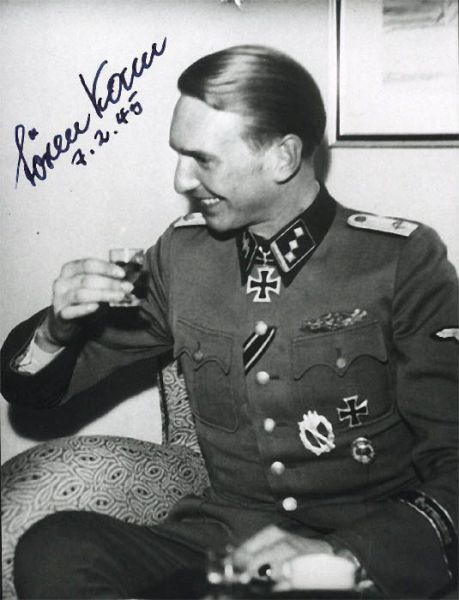Kam, Søren (Waffen SS)
- Date of birth:
- November 2nd, 1921 (Kopenhagen, Denmark)
- Date of death:
- March 23rd, 2015 (Kempten, Germany)
- Service number:
- SS-Nr.: 456.059 // NSDAP-Nr.:
- Nationality:
- Danish (1849 - present, Const. Monarchy)
Biography
Promotions:
- 2 September 1941 SS-Sturmmann
- 30 November 1941 SS-Rottenführer
- 20 April 1942 SS-Unterscharführer
- 1 May 1942 SS-Junker
- 1 September 1942 SS-Standartenjunker
- 20 December 1942 SS-Standartenoberjunker
- 30 January 1943 SS-Untersturmführer
- 7 February 1945 SS-Obersturmführer
Do you have more information about this person? Inform us!
- Period:
- Second World War (1939-1945)
- Awarded on:
- September 22nd, 1941
- Period:
- Second World War (1939-1945)
- Period:
- Second World War (1939-1945)
- Period:
- Second World War (1939-1945)
- Awarded on:
- 1942
- Period:
- Second World War (1939-1945)
- Awarded on:
- April 20th, 1944
- Period:
- Second World War (1939-1945)
- Awarded on:
- 1944
- Period:
- Second World War (1939-1945)
- Awarded on:
- 1944
- Period:
- Second World War (1939-1945)
- Rank:
- SS-Untersturmführer (2nd Lieutenant)
- Unit:
- Führer, 1. Kompanie, SS-Panzer-Grenadier-Regiment 9 "Germania", 5. SS-Panzer-Division "Wiking", IV. SS-Panzerkorps, Heeresgruppe Süd
- Awarded on:
- February 7th, 1945
“During the hard defensive battle against overwhelming Soviet forces between the Vistula and Bug rivers (north of Warsaw), which began on the 10.10.1944 and continues to this day, SS-Untersturmführer Kam once again distinguished himself through incredible courageous and exceptional steadfastness.
On the 26.10.1944 the enemy attacked the positions of Kam’s Kompanie (which lay 2.5-3 km northwest of Wieliscew) following a heavy preparatory barrage by artillery, mortars and ground attack planes. The Soviets wished to take the decisive Hill 86 (which was of massive importance for the Division’s continuation of the defensive battle) at any cost.
The defensive positions on Hill 86 (which rose as a single sandy height above the surrounding area) were completely smashed by the enemy drumfire. Kam’s Kompanie suffered substantial losses. By attacking from the east and north, and with heavy fire support from the domineering north bank of the Bug, the enemy was eventually able to capture the hotly contested Hill 86.
Following an immediate counterthrust that Kam personally led on his own initiative, the enemy was thrown off the hill. In the meantime however the Soviets had also managed to penetrate into the forest west of the hill. A bitter fight erupted which saw the hill lost to the enemy once again.
Over a period of 6 hours Kam and the remains of his Kompanie counterattacked the hill a total of 5 times, each time taking it and then losing it shortly afterwards. This continued until 15:00, when they were able to finally gain a firm control over it. With his few remaining soldiers Kam defended this place against all enemy attacks, which by now were also coming from the hill to the west. The fire of the enemy heavy weapons, especially on the commanding north bank of the Bug, increased noticeably.
Kam stood his ground until the fighting ceased in the evening, by which time his force had been reduced to 7 men.
It was only the boldly conducted counterthrusts and the death-defying, fanatical resistance of SS-Untersturmführer Kam and his men that made it possible to prevent the Soviets from taking control of Hill 86 and from here collapse the entire defensive front of the Regiment.
Kam is a Germanic volunteer/Dane, and the student of an SS-Obersturmbannführer from Schalburg. This dashing and brave SS leader has encouraged Germanic volunteers through his invigorating words and personal example in this time of momentary political crisis.
Indicative of his determination is that he flew into the Cherkassy pocket on the 09.02.1944 despite orders to the contrary, and in the fighting which followed he continued to lead his Zug during the breakout of the 17.02.1944 despite being badly wounded in the head.
The Regiment considers SS-Untersturmführer Kam as particularly worthy of being decorated with the Knight’s Cross to the Iron Cross.”
- Period:
- Second World War (1939-1945)
- Awarded on:
- 1945
Sources
- Photo 1: Andrew Straube
- - Fellgiebel W.P., Elite of the Third Reich, The recipients of the Knight's Cross of the Iron Cross 1939-1945: A Reference, Helion & Company Limited, Solihull, 2003, ISBN 1-874622-46-9
- Axis Biographical Research
- Microfilm Publication A3343. US National Archives.











